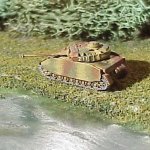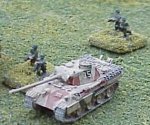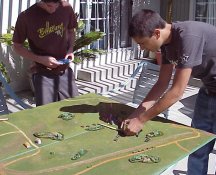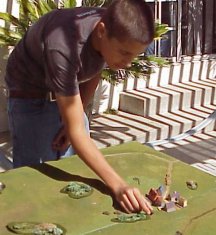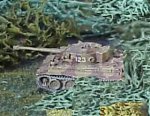|
Panzer War is a turn based rules system that tries to take into account time in the sequence of events. The basic premise of the game is that elements that take the most time moving will use their weapons the least amount of time. In this way tanks and other vehicles that move the most will delay the segment that they fire in.
The Turn
The game consists of a series of turns. Each turn is divided into a series of repeated steps or phases. Some of these are divided into even smaller units called segments. Both players may move and have combat in the same turn. Each turn represents actions done in a set period of time (about 75 seconds). Players on both sides get to play in each of these phases and do not have to wait until they get their own 'turn'.
Troops that remain stationary in a turn will shoot before those that have moved.
The Troops
Troops are organized into platoons and companies. The smallest element of armor is a single tank. Usually 3-5 tanks will be a platoon, while 10 to 17 tanks will be a company. An element of infantry is the squad stand. 3-6 of these will be a platoon. 3-4 platoon will be a company. Players will command one or more companies of troops.
Movement
The movement phase is divided into several segments. Tanks that choose to move will move in only one of the movement segments; these are the shift movement segment, the half movement segment, or the full movement segment. Which occur in that order.
Combat
Once all elements are done moving in a turn the firing order is reversed. All stationary tanks fire first. All tanks on either side firing in this segment fire simultaneously and thus it is possible that two tanks will shoot and destroy each other. Continuing to the next group, the tanks that moved just a little bit (a shift move) may fire. Next all the half moving tanks fire. Lastly all the tanks that moved full fire.
There is a second chance of some tanks to fire. A stationary tank may fire a second time in the half moving segment and a shift moving tank may fire a second time in the full moving segment.
That's all there is to the basic idea. There of course are exceptions for tanks with low rates of fire, ace tank crews and some other factors.
So let's do a little training.
Scenario
A scenario is an outline of a game. The general situation, the number and kind of game pieces, the start positions and game objectives are all set by the scenario. To find which game pieces and table setup that players will use will spelled out. Also, the number and kind of troops and vehicles one each side will be stated in the scenario. Scale terrain will be on the game table that will influence game objectives. With this information each side will design an overall game plan.
Tactical Orders
Each turn begins with writing or in some way recording the tactical order each platoon or company will do in the ensuing turn. The order tells the unit how much to move in the following movement part of the turn. Recorded orders are the reason the game can be played in a simultaneous fashion. Players can't change how they plan on moving even when they see what their opponents are doing. Tactical orders are very blunt and consist of a single word, like Cover, Rush, Charge, Bound, Withdraw, ...
Movement Go to a more detailed movement drill
As stated above the movement phase is divided into several sub-phases or segments. Now depending on the type of order given each platoon the platoons doing the most moving will go first. When troops are far apart both players can move their troops. When troops are real close only one side at a time should move even though it is considered to all be happening at once (simultaneous). As they must follow their orders there no stopping if they have Advance, Charge or Rush orders.
Seeing the Enemy Go to a more detailed sighting drill
Now each side will try to determine if they can see each other. Distance and line-of-sight will be the most important factor as well as if the enemy is to the front or the side of the sighting tank. Tanks and other armored vehicles can sight as a group or individuals depending on their situations. Once things are sighted they can be fired on by direct line of sight weapons.
Shooting at the Enemy Go to a more detailed combat drill
Tanks that did not move may fire at enemy sighted previously. Measure to find the range to the enemy target. Check the Gun tables. Roll a ten sided die to score a high number and it may hit. Roll a ten-sided die to see where on the enemy vehicle a hit is taken. Roll a six sided die to see if the penetration of the gun defeats the protection of the armor. If the armor is defeated roll a ten side die to see if the target vehicle is destroyed or damaged in another way. There is no Dungeons and Dragons like 'saving throws' but failure to make the required die score saves the target vehicle just the same.
All tanks that did not move on either side get to fire away in the same combat segment. It is theoretically possible that two tanks may destroy each other in the same phase. This doesn't happen that often.
|
|
